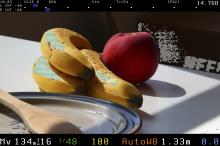Replace areas in the image that are above/below a certain luma value with a moving stripes "zebra" pattern to indicate over/under exposure areas.
Parameters:
- Direction of the stripes
- Color of the stripes
- Overexposure-threshold
- Underexposure-threshold
- ON/OFF
Magic Lantern example:
